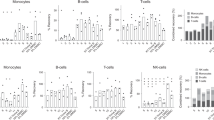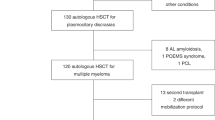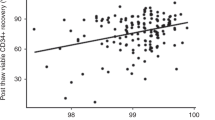Abstract
The efficiency of five different cryopreservation protocols (our original controlled-rate and noncontrolled-rate protocols) was evaluated on the basis of the recovery after thawing of very primitive pluripotent hemopoietic stem cells (MRACFU-GM), pluripotent progenitors (CFU-Sd12) and committed granulocyte–monocyte progenitors (CFU-GM) in mouse bone marrow. Although the nucleated cell recovery and viability determined immediately after the thawing and washing of the cells were found to be similar, whether controlled-rate or noncontrolled-rate cryopreservation protocols were used, the recovery of MRACFU-GM, CFU-Sd12 and CFU-GM varied depending on the type of protocol and the cryoprotector (DMSO) concentrations used. It was shown that the controlled-rate protocol was more efficient, enabling better MRACFU-GM, CFU-Sd12 and CFU-GM recovery from frozen samples. The most efficient was the controlled-rate protocol of cryopreservation designed to compensate for the release of fusion heat, which enabled a better survival of CFU-Sd12 and CFU-GM when combined with a lower (5%) DMSO concentration. On the contrary, a satisfactory survival rate of very primitive stem cells (MRACFU-GM) was achieved only when 10% DMSO was included with a five-step protocol of cryopreservation. These results point to adequately used controlled-rate freezing as essential for a highly efficient cryopreservation of some of the categories of hematopoietic stem and progenitor cells. At the same time, it was obvious that a higher DMSO concentration was necessary for the cryopreservation of very primitive stem cells, but not, however, for more mature progenitor cells (CFU-S, CFU-GM). These results imply the existence of a mechanism that decreases the intracellular concentration of DMSO in primitive MRA cells, which is not the case for less primitive progenitors.
This is a preview of subscription content, access via your institution
Access options
Subscribe to this journal
Receive 12 print issues and online access
$259.00 per year
only $21.58 per issue
Buy this article
- Purchase on SpringerLink
- Instant access to full article PDF
Prices may be subject to local taxes which are calculated during checkout
Similar content being viewed by others
Author information
Authors and Affiliations
Rights and permissions
About this article
Cite this article
Balint, B., Ivanović, Z., Petakov, M. et al. The cryopreservation protocol optimal for progenitor recovery is not optimal for preservation of marrow repopulating ability. Bone Marrow Transplant 23, 613–619 (1999). https://doi.org/10.1038/sj.bmt.1701623
Received:
Accepted:
Published:
Issue date:
DOI: https://doi.org/10.1038/sj.bmt.1701623
Keywords
This article is cited by
-
Cryopreservation of equine mesenchymal stem cells in 95 % autologous serum and 5 % DMSO does not alter post-thaw growth or morphology in vitro compared to fetal bovine serum or allogeneic serum at 20 or 95 % and DMSO at 10 or 5 %
Stem Cell Research & Therapy (2015)
-
Impact of uncontrolled freezing and long-term storage of peripheral blood stem cells at −80 °C on haematopoietic recovery after autologous transplantation. Report from two centres
Bone Marrow Transplantation (2014)



